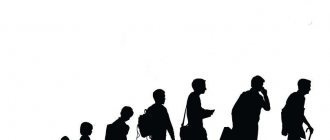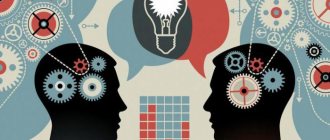Social perception: effects, phenomena and types
It is worth examining a narrower area of this concept. Social perception is a process of cognition that is achieved by creating an idea of oneself and other members of society. In short, it is a way for an individual to understand himself. The concept of social perception was proposed in 1947 by J. Bruner.
It is customary to distinguish the following effects of social perception:
- stereotyping - a formed image, a stamp.
- halo - the general opinion about an individual is transferred to the hidden traits of his character. If a person has unique natural characteristics, society will consider him good.
- novelty - the formation of an opinion about a stranger occurs on the basis of the first impression. This opinion is often wrong because the first impression is based on many factors that do not reflect internal qualities.
- primacy - when creating an image, the emphasis is on the information that was learned first. All subsequent experience is formed based on it.
- role – the perception of role functions as character traits. For example, all teachers are usually perceived as strict.
- presence – in the presence of other people, a person tends to demonstrate the skill that he or she masters best.
- advance - attributing to a person traits that are not characteristic of her and further disappointment in her. This is due to the so-called faith in people; I want to think that they are all good.
- condescension – exaggerating the role of positive qualities while denying negative character traits.
- hyper-demanding – a person sees only negative qualities and turns a blind eye to positive ones.
- physiognomic reduction - a judgment about qualities based on appearance.
- beauty – attractive people are attributed more positive qualities.
- expectation – provoking in a person the reaction that we want to get from him.
- In-group favoritism is always better.
- presumption of reciprocity - the individual thinks that the opponent treats him the same way as he treats him.
- projection - consists of a person attributing his positive qualities to a person who is pleasant and attractive to him.
Phenomena of social perception:
- assumptions about similarity - the person believes that “their” people should treat everything the same way as she does. The need for community is deeply embedded in us; we want those close to us to be like us, to think like us.
- ignoring the information value of what did not happen - it is customary to ignore information about what could have happened, but in reality did not happen. This is why it is so difficult to learn from other people's mistakes.
The following types of social perception are distinguished:
- An individual of himself, his own or another group.
- Members of each other's group or members of another group.
- A group of your own people and members of another group.
- A group of another group.
To understand the essence of social perception, let's first get acquainted with its components. The mechanisms of social perception are presented as follows:
- Social stereotyping is the formation of an opinion about a person, which is based on his membership in a certain group. Let's take a well-known stereotype as an example: all Ukrainians drink gorka. Thus, when a person meets a Ukrainian, she has a stamp about his qualities.
- Identification is the recognition of an object through the analysis of some known features. For example, having met a person in a school mathematics classroom, you can draw the following conclusions about him: he is a mathematics teacher or studies this subject.
- Empathy is the ability to understand a person, his internal state. We are more willing to sympathize with someone whose emotions and experiences are close to us.
- Attraction is the knowledge of another through the formation of a positive feeling for him. In the process of falling in love, you can recognize your partner and at the same time see only positive qualities in him.
- Reflection is a process of self-knowledge by rethinking one’s qualities.
- Causal attribution is the creation of an image through the actions and emotions of another person. From childhood, our parents teach us that if a person does bad things, he is evil.
Pedagogical social perception
Perception in pedagogy is a cognitive process that forms a subjective picture of the world. This is an important aspect of cognition, because moral standards are laid down in childhood. At school, the child is in society, learns to communicate, and analyze the behavior of peers. One of the aspects of pedagogical perception is attitudes.
Social pedagogical attitude is the teacher's assessment and reaction in a certain way to students or learning situations that have been formed on the basis of past experience. They can be positive or negative.
Positive pedagogical attitudes can have a beneficial effect on the learning process. Students see that the teacher trusts them and believes in them. This encourages them to study better, develop creativity and be disciplined.
In this case, the “Pygmalion effect” applies. This is an ancient Greek sculptor who created a beautiful statue of a girl. She was so beautiful that he fell in love with her. His love was so strong that it could bring the statue to life. In the same way, a teacher can inspire in students a desire to develop and become better.
Communication as social perception
Perception in communication is the exchange of information during interaction with other members of society. Most often this happens in the form of dialogue, the goal of which is to achieve complete mutual understanding.
Perceptual communication is one of the ways to build interpersonal relationships, based on the ability to understand the inner world of the interlocutor. Perceptual communication carries the following set of functions:
- creating a soil that will allow you to better understand other people;
- development of prerequisites for good mutual understanding with the opponent;
- ensuring that the influence of interlocutors on each other is positive. .
Formation mechanism
Mechanisms:
- Identification. Comparison of the subject with images that were perceived before. It is built on personal experience, which can be practical and theoretical.
- Stereotyping. The image, the idea of a person, his behavior, actions is built on stereotypes.
- Empathy. This mechanism is expressed in people who know how to worry about others, sympathize, and express sincere emotions regarding the problems of other people.
- Attraction. The mechanism of attracting people to each other. These are friendships or love relationships between individuals who communicate frequently with each other. Gradually they become attracted and begin to work together. The attraction consists of common interests, topics, and frequent meetings.
- Reflection. A mechanism of self-immersion to focus on one’s own interests, thoughts, behavior, and actions.
The mechanisms can manifest themselves singly or in complexes.
The role of perception in psychology
Perception in psychology is an important psychological function of cognition. It allows you to determine how a person sees and perceives various things. The psychological mechanisms of social perception can be found above.
It is classified depending on the working organs of perception:
- Visual. This is the perception of the surrounding reality with the help of the organs of vision: recognition of colors, determination of distance, and more.
- Tactile. With the help of hands, many things are recognized and their interaction on the individual. For example, pain makes it clear that high temperatures are harmful to the body.
- Auditory. The auditory perception of the world occurs through the human ear. The human ear allows us to get a complete picture of the world thanks to sounds.
Development methods
Ways to improve:
- Meditation. Can be carried out individually or in a team. With their help you can quickly relieve moral and physical stress. Meditation allows you to suppress anxiety, get rid of negative thoughts and fears. Psychologists recommend combining meditation with breathing techniques to achieve greater effect.
- Games. They can be situational, business, creative, thematic. With their help, you can improve relationships between friends or colleagues. Games help overcome shyness, stiffness, and internal tension. With the help of gaming techniques, skills are quickly consolidated, behavior changes, and non-verbal skills are developed.
- Development of perception. The specialist demonstrates exercises to the participants, with the help of which they must non-verbally or verbally understand how they are perceived from the outside.
- Group discussions. Allows you to analyze issues of interest, problems of the team that interfere with development and achievement of set goals. Joint discussion helps to look at the situation from different angles, find uncharacteristic ways to solve the problem, and identify hidden opportunities.
You can improve the quality of social perception, learn to understand people better, and convey information better using the methods of psychologist Paul Ekman. The point of the practice is to, when communicating with another person, concentrate attention on three areas of his face - nose, chin, forehead. These zones are significant in the expression of sadness, disgust, fear, and anger. To better convey emotions, you need to use gestures.
Internal perception, effective interpersonal relationships, and intuition can be developed with the help of spiritual practices and trainings. It is better to use them at a young age, since in childhood the senses perceive the world around them better.
The essence of interpersonal perception
Interpersonal perception is a side of communication that includes the exchange of information and interaction, which is influenced by such factors: the subject’s activity, expectations, intentions, past experience, situation, and more.
Mechanisms of interpersonal perception
The perception of another person allows the personality to shape itself, because during this the relationship of the personality with the opponent occurs. To achieve the goal, long-term joint activity between them is necessary.
The development of self-awareness through the process of analyzing oneself through another is carried out through the following mechanisms:
- Reflections are rethinking your actions and feelings.
- Causal attribution is the concept of one’s mistakes through the achievements of another.
We are designed in such a way that the process of studying the world around us never ends. New items and technologies appear that need to be analyzed. We meet new people and form a certain opinion about them. The process of introspection and soul-searching continues throughout our lives. We are changing, the structure of the world is changing. All these aspects point to the importance of a correct understanding of everything that surrounds us.
I hope this article will be useful to you. If your boss doesn’t like you, then this depends only on the effect of hyper-demandingness, and not on the fact that you have no positive qualities.
Aspects
Perception first appears at the stage of visual analysis of the communication object. Thus, physiognomy claims that there is a connection between an individual’s facial features and his psychological characteristics. Based on an assessment of the interlocutor’s appearance, the first assumptions are made regarding his inner world and behavior.
Then some emotional contact is formed. If the conversation has an unpleasant context, a negative perception of the opponent may well be formed. And vice versa.
In the process of communication, people observe their partner’s speech, facial expressions, gestures, and habits, receiving verbal and nonverbal information about his personality.
Perceptual hook
At the moment of perception, the observed person appears before the observer as a certain set of socially significant attributes that are traditionally used to translate psychological traits and states in a particular culture. Attributes, or, as they are also called, “perceptual hooks,” which are the well-known social code of a particular person. The meaning of most of them was deciphered for him by his parents and other close people, some were deciphered by him, and some were assigned to him in the process of communicating with examples of his culture. These “hooks” are partly international: their interpretation is almost the same in different cultures and communities. At their core, they are attributes that decipher basic human emotions for us: Joy, fear, pain, etc. The rest, and they are the majority, are of “local significance”: born into a certain ethnic, social or even professional group. To interpret them correctly, it is important to know the culture of a particular group; it is better to be involved in it from birth.
A person's face is the main source of information about the perceived person. Of all the parameters, the most important for us are facial expression and eyes. Micro movements of the facial muscles can convey a wide range of feelings and experiences. The most important and “honest” information is provided by facial expressions about a person’s state: he is happy, sad, angry, worried. From the point of view of translating stable personality traits, its capabilities are very limited.
Enough has already been said about the eyes as the “mirror of the soul.” It should only be noted that the eyes themselves (from a materialistic point of view) are meaningless. They are created thanks to micro movements of the muscles around the eyes. But they do it masterfully, and our ability to perceive and interpret these movements is equally masterful. Here are just a few of the culturally embedded interpretations.
Direct look. Research shows that a person is not able to perceive the direct gaze of a communication partner for more than three seconds without feeling discomfort. The “right to a long, straight look” is correlated in culture with a person’s status and power: The greater they are, the longer a person can look “straight”.
Direct gaze is perceived subjectively:
- Like a challenge;
- As a proposal to reduce personal distance in communication.
Refusal of eye contact. Subjectively perceived by the observer as punishment or a means of manipulation.
"Eyes that do not see." Subjectively perceived as an indicator of aggressive intentions, threat or defensive (usually also aggressive) reaction.
Stereotyping
A stereotype is a stable image or idea of any phenomena, persons, or events, characteristic of representatives of a certain social group. Stereotyping is the process of forming an impression of a perceived person based on stereotypes developed by a group.
Various social groups, real (nation) or ideal (professional group), develop stereotypes, stable explanations of certain facts, habitual interpretations of things. This is quite logical, because stereotypes are a necessary and useful tool for social perception of the world. This allows you to quickly and reliably classify and simplify the social environment at a certain level. To make it understandable and therefore predictable.
The emergence of social stereotypes is associated with certain social situations. In any specific situation, this or that image performed the listed functions well, and therefore became entrenched in the form of a stereotype. But the social position of the group and its members changes much faster than the stereotypes they create. Thus, the stereotype takes on a life of its own and influences the development of the group's relationships with other people and between a particular person and other people.
Group stereotypes in their formation often go through a stage associated with the formation model of “social pronouns”: “they - we - I”. More precisely, first the other group (the one in relation to which the stereotype is formed) has a qualitative definition. One's own group is literally defined as “that which is not...”, that is, through negation. Only later do their own qualities appear, which are not necessarily based on the “vice versa” principle.







